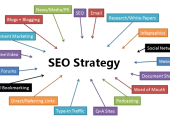10 Tips for Optimising Your eCommerce Site
eCommerce Search Engine Optimization (SEO) is a competitive strategy that you need to adopt to attract more customers. SEO for an eCommerce site will ultimately result in a higher return on investments and enhanced brand awareness & visibility. In order to attract more customers, you need to rank higher on SERPs, and there are two ways to achieve it. You can either take the help of sponsored ad campaigns or organically optimize your website for the crawlers. The cost associated with paid ad campaigns is relatively higher while optimizing your eCommerce website is free. One of the major perks of running an eCommerce site is that geography is not a boundary, allowing you to optimize your site for all geographic locations. Global optimization makes your business grow at a rapid pace.
In this article, you will learn about eCommerce SEO and what you can do (on-site and off-site optimization) to achieve the desired results.
Let’s get started.
What is eCommerce SEO?
Search Engine Optimization (SEO) is a fundamental and crucial necessity for an eCommerce site. eCommerce SEO is a set of optimization techniques that enables your site to rank higher in search engine result pages (SERPs). It allows you to appear in more relevant and realistic results, resulting in increased quality traffic and leads, and ultimately sales required to grow your brand in an online marketplace.
Optimizing content-based websites is comparatively easy, and all it requires is adding relative keywords, curating quality content, gaining backlinks, and publishing blog posts. While optimizing an eCommerce website for a higher rank in search results is beyond that. For optimizing your CMS eCommerce website, you first need to understand how the respective search engine works and what practices they reward.
You must have an idea about Google’s guidelines, analyze your buyer intent, and execute it strategically in order to get your desired results.
CMS eCommerce SEO includes optimizing your headlines, metadata, internal link structure, product descriptions, navigational structure, and internal link structure for an effortless and satisfying user experience. You must also optimize the static pages of your eCommerce websites, like the company page, the home page, the FAQ page, blogs, the contact us page, and the help center page.
Experts say that SEO has 20 times more quality traffic opportunities and success rates than paid ad campaigns on both desktops and mobile phones, making it the most crucial practice to achieve your goals organically.
Why is eCommerce SEO Important?
The simple and base point of eCommerce SEO is that your products need to rank higher on the search results than your competitors. Mastering the eCommerce SEO game will organically fetch you unbelievable results in the long run. eCommerce SEO fetches you excellent results if you focus both on on-site and off-site optimization.
Here are a few ways that state the importance of eCommerce SEO.
- You aid your target audience in discovering your brand without spending a fortune. Ecommerce SEO is the best practice that allows you to help your target audience find your offerings. With the right strategies, you can score a high rank in the SERPs and let more people discover your brand.
- You can market your offerings to the relative masses. Your target audience actively searches for the products that your eCommerce site offers. With eCommerce SEO best practices, you help increase brand recognition and product visibility.
- You can provide an excellent user experience to your audience. A better and positive user experience results in a result-oriented brand association, resulting in sales.
- When people are looking for products you are offering and find your products in search, you attract quality leads that are more likely to convert into actual sales.
With the right eCommerce SEO strategies executed, you can effortlessly rank high, and your product pages will provide the best solutions to your target audience’s search intent. In addition to that, it can yield an ongoing and free source of continuing and high-converting traffic to your eCommerce site.
10 Tips for Optimising Your eCommerce Site for conversions
Here are a few tips that will help you effortlessly optimize your eCommerce site and witness an upward moving movement in your organization’s growth graph. These tips are derived from the result-oriented strategies of the top 5 eCommerce platforms across the globe.
1- Perform Keyword Research To Rank Higher in Relevant Search Results
In executing your eCommerce SEO practice, the foremost step is performing extensive keyword research. Keywords are the terminologies that your target audience uses to search on the respective search engines to find relevant products.
The keywords help your products appear in front of your target audience. Respective search engines use keywords to determine the relevancy of your product page and thus show in the search results. Hence, it’s essential to choose the right and relevant keywords for your products so that you can appear in the relevant search results, improving your chances of conversion over your competitors.
In order to find the relevant keywords for your products and eCommerce site, you must use a keyword research tool. There are plenty of free keywords finding tools available online, however, with restricted access. You can choose the perfect tool and pay for its extended version to have complete access.
For instance, let us find relevant keywords for heels for women on a free keyword finder called Ubersuggest.
You know the relevant keywords from your primary term, “heels for women”, which you can try to accommodate in your product pages via headings, meta descriptions, image anchor text, and product descriptions.
Source – Ubersuggest
While conducting your keyword research, you must prefer long-tail keywords over short-tails ones. Long-tail keywords contain three or more words and are specific in nature, attracting narrowed and quality traffic that is highly potent to convert into sales.
On the other hand, short-tail keywords generally contain just one or two words and can work favoring your eCommerce website. They are highly competitive in nature and are quite challenging to rank despite continuous exemplary efforts.
2- Create Not Just Quality But Helpful Content
Once you are through with your extensive keyword research, you must work on content-creating strategies to get excellent results. Content is king, and it will help you rank in different search results and drive more relevant and quality traffic to your page. In addition to that, great content will help you build a search engine-friendly website.
For creating content, you need to pick up topics that are meant to solve problems and are informative. Stick to topics related to your industry and the nature of your products. In order to create impactful content,
- You must incorporate your target keywords. Share a realistic experience with your target customers so that they exactly know what they are looking at and what they should expect from the product if they decide to buy. It can be done by naturally stuffing your keywords in your content. Refrain from overdoing it.
- Create content that matches the search intent. Take your keywords and look for what your competitors are writing around that. It helps understand the purpose and thus create content to match it, allowing you a fair chance to rank higher in the SERPs.
- Create a flow and format your content nicely because you are writing for humans to solve their problems by offering your products. It is essential to write conversational content in order to present the information clearly and in an easy-to-understand manner. Try including simple language and refrain from using technical terms to enhance engagement.
- You wish that your target audience can quickly get the product information they are seeking, provoking the instant purchase. For that, you need to ensure that your content is easily scannable. The gist includes short paragraphs, bullet pointers, and short headings.
3- Make Clickable Titles
The title tag is the first thing your target audience will see in the search results when they come across your listings. Optimizing your title tags is an essential practice for eCommerce SEO because Google uses the title tags to identify your page’s context. Optimized title tags are crucial as they are the direct ranking factor for Google.
You need to have optimized title tags for all the pages on your eCommerce site. Not just this, you’ll have to come up with something quirky and enticing that compels your target audience to click on your listing.
The audience tends to read only the first few words of the title tags, and hence, having the primary keywords about your product as the first words of your title tags increases your chance of probable customers clicking on your listing. It also boosts your content’s rankability.
Optimizing title tags can be tedious. Because you do not just want to create enticing titles for your pages but also would like to stick to the character limit Google has for you. You have to wrap your title tag within 60 characters.
4- Write Buying Intent Provoking Meta Descriptions
Meta descriptions usually appear below the title tags in search engine results. You must give a summary description of your products (within 160 characters) in the meta description. Your meta description must communicate what the buyer will get and what he should expect from the product.
Meta descriptions play a vital role in offering shoppers information about the page and creating curiosity, compelling them to click on the link. You must also include your primary target keywords in your meta descriptions. It helps both Google and the target audience understand the relevancy of your page to the search results, deciding your rank.
5- Generate User-friendly URLs
One of the best and most efficient practices of eCommerce SEO is to incorporate user-friendly URLs to all your pages. Instead of a confusing thread of random letters and numbers, you must use the primary keywords of your page in the URL. This helps better rank on the SERPs and allows your target audience to remember your product page easily.
eCommerce website mostly has categories of products. Hence, it is essential and helpful to mention your product’s primary category. It facilitates better navigation and promotes an excellent user experience. Generating clear and user-friendly websites will help you make a search engine-friendly website too.
6- Improve Your Site Architecture
As an eCommerce website, you have hundreds of product pages. It is essential to keep your pages, both category and individual product pages, organized to offer seamless and effortless navigation for your customers.
To improve your site structure.
- You must keep your website pages organized. One of the essential aspects of site architecture is that it has to be organized and follow a logical path. It becomes easy for site visitors to backtrack when you have an organized site path. You can take the help of navigational breadcrumbs to help you stay organized.
- As an eCommerce store, adding new pages and new products or content is inevitable. The architecture of your site must be designed to handle the new additions efficiently. It becomes easy for the site to scale without compromising on the ease of an efficient site architecture plan.
7- Optimize Your Images
Product images not only help the buyers to visualize the product but to have an idea about whether the purpose behind buying it will be satisfied or not. As an eCommerce store, you are bound to have numerous images on your site, making your site slow and bulky.
Neither Google nor your probable customers find a ridiculously slow site fascinating. In order to keep your images weighing down your eCommerce site, you can leverage image compression tools to size up your pictures.
Apart from compressing your images, you must also add alt text to the images to help you rank in image search results. Adding alt text allows you to integrate related keywords on your product page and rank higher in search results.
8- Don’t Overlook The Need for Site Speed Optimization
A relatively fast site can increase your conversions by 7%
Slow eCommerce stores can lose potential customers because nobody has the patience to wait in today’s world. You can enhance the speed of your page by using.
- Host the video streaming through third-party platforms like YouTube.
- Compress heavy CSS, Javascript, and HTML files.
- Clean up your code and remove unnecessary elements
- Check your server configuration
- Enable browser caching for fast loading
- Reduce the number of redirects
If you want to check the speed of your site, you certainly can use Google’s Page Speed Insights tool. Even after applying all the points mentioned above, if your site’s page speed is still slow, you can invest in site speed optimization services.
9- Integrate Responsive Design For an Excellent User Experience
.Most modern-aged buyers prefer to buy products from their smartphones. So, if your eCommerce website is not mobile responsive, it won’t rank higher on the SERPs. After the updates in Google’s algorithms, it now uses mobile-first indexing to rank sites in the SERPs. With the help of responsive design, you allow your site to adapt to all your audience’s devices. It ensures a fantastic experience for your potential customers.
A good, responsive design allows your web pages to look flawless irrespective of the device. You can make your site responsive by
- Designing elements for both touchscreen and mouse.
- Using a fluid code in your website’s code.
- Select elements that offer the best and unbeatable experience to include on smaller screens.
- Try the predesigned responsive layouts.
You can check how mobile-friendly your website is by using Google’s Mobile-Friendly Test Tool.
10- Highlight Your Products With Schema Markup
Schema markup is a code that allows you to add features like prices, product reviews, and available stock to your product page. It also boosts your SEO for eCommerce as it helps Google understand your page better. The schema markup allows you to identify yourself as an online entity and establish what products you sell.
Read on: how to use ubersuggest to improve your website rankings
Conclusion
Most eCommerce businesses want increased conversions and revenue from day one, but practically and ethically, that is not the right thing. In order to convert customers, you first have to understand their needs, engage with them by creating quality and informative content, and answer any questions they might have about the product & brand. Once they have built trust in your brand, they will eventually convert into actual sales. In addition to that, they will be the best brand promoters you can ever wish for.






